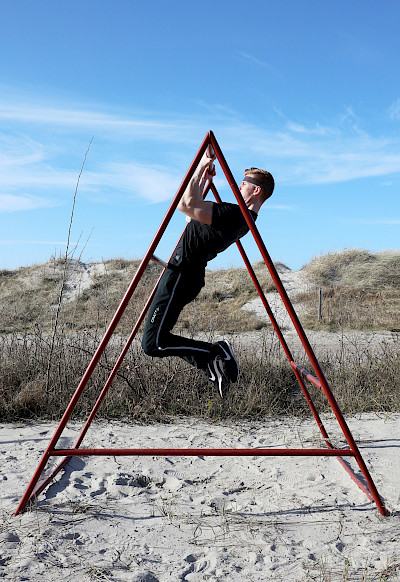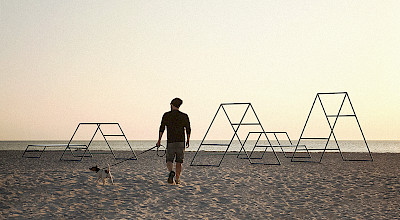Nola has contributed to furnishing Hamntorget - a new social meeting place along Årstaviken promenade in Södermalm, Stockholm.
Healthy training in the urban environment
2020–04–21
2020–04–21
Nola strikes a blow for healthy urban environments. Outdoor training at attractive outdoor gyms should be a natural feature of the cityscape and should be included right from the planning stage of urban development.

Kebne outdoor gym and its modules, design by Kauppi & Kauppi for Nola.
The positive effects of exercise, such as a better general feeling and stress management combined with fresh air, provide an excellent foundation for healthy cities and environments. Shared areas for sport and exercise are important so that more people have the opportunity to be active, and for improved public health. When indoor gyms are closed, or have limited opening hours, there is a greater need to open up spaces in the city for exercise. An outdoor gym can be built in both urban and park environments, not just next to a fitness centre or exercise trail. The opportunity for movement and sport should play a more important role in the design of cities and should be reviewed right from the urban planning stage. Some existing initiatives, such as the Swedish Sports Federation and the architectural firm FOJAB, recently started collaborating to develop the Movement Factor - a tool to more easily integrate and plan for physical activity in the urban environment.
Outdoor training is easily accessible and creates naturally healthy meeting places. A complement to heavy weights, expensive gym cards and cramped indoor spaces. An outdoor gym provides access to spontaneous exercise and movement at all hours of the day, all year round - with a healthier lifestyle as a result. There are many benefits to outdoor training, both economic and socio-economic. It promotes mental well-being, reduces sick leave, encourages young people to meet constructively, creates social cohesion. Outdoor gyms also have the advantage of being possible to place anywhere in park environments, next to playgrounds and squares, in public places and open spaces.
Calisthenics is another word for body weight training, where the body is used as the main piece of equipment and weight, for developing physique and mastering exercises. The training form builds functional strength, as several muscle groups are trained at the same time, and strengthens joints and tendons. The risk of injury is also reduced by using one's own body weight as a counterweight instead of heavy weights. The term comes from the ancient Greek words kallos perfectly beautiful and sthenos strength. Calisthenics is a popular form of training today but has long been used by e.g. the military and bodybuilders.
Calisthenics är ett annat ord för kroppsviktsträning, där kroppen används som främsta redskap och vikt, för att utveckla kroppsbyggnad och bemästra övningar.


Kebne is not just an outdoor gym, but a whole family of activity furniture for natural exercise and physical activity in landscapes or urban spaces. The outdoor gym consists of simple units for body strength training and stretching, focused on body weight training. Kebne is designed by designer duo Kauppi & Kauppi, with special care to welcome everyone regardless of their height, age, gender or level of training. Exercises can easily be adapted using the different modules, with the body acting as different levels of resistance, and are suitable for training in all seasons. The system includes an inspiration map with graphics demonstrating the most common exercises. Kebne is environmentally assessed and has been awarded several international awards for its product design. Kebne outdoor gym more info
Nola has contributed to furnishing Hamntorget - a new social meeting place along Årstaviken promenade in Södermalm, Stockholm.
Architects Liljewall installed Nola’s Blenda bike stands in the concourse outside Stockholm's iconic Tomteboda building, an architectural landmark. As Blenda’s integrated LED lighting units show cyclists where to insert locks, they light up the surroundings for pedestrians too.
A former car park has been refurbished and transformed into a social and safe meeting place for residents in Fittja.
The Sigill park bench is designed to withstand the harsh Nordic climate and satisfy the demands for sustainable production and materials.
The Gällivarebänk is designed as a flexible modular system that can be easily varied and adapted to different needs.
Nola is launching a brand new digital planning tool for the Korg furniture system. The tool makes it possible to spatially create and test ideas and solutions according to your specific requirements.
A green restart of the economy requires new solutions in bicycle infrastructure, for healthier cities and a more sustainable society.
The classic park bench for Kungsträdgården was developed in 1998, based on an older model in cast iron and painted pine. This park bench is currently in production again.
Designed by Malmström Edström and 02 Landscape Architects, the Viva urban housing development won the prestigious Kaspar Salin architecture award. Nola’s Hjorthhagen furniture group was chosen for the site’s landscaped gardens and community areas.
Nola will showcase new designs at the 2020 edition of the Stockholm Furniture & Light Fair from 4 - 8 Feb 2020. This year, you’ll find us on stand A11: 19, as well as at a few other Stockholm Design Week events throughout the week.
Nola has long worked towards both social and environmental sustainability and at this year's edition of the Stockholm Furniture & Light Fair, the latest steps in the work towards a better future are being presented.